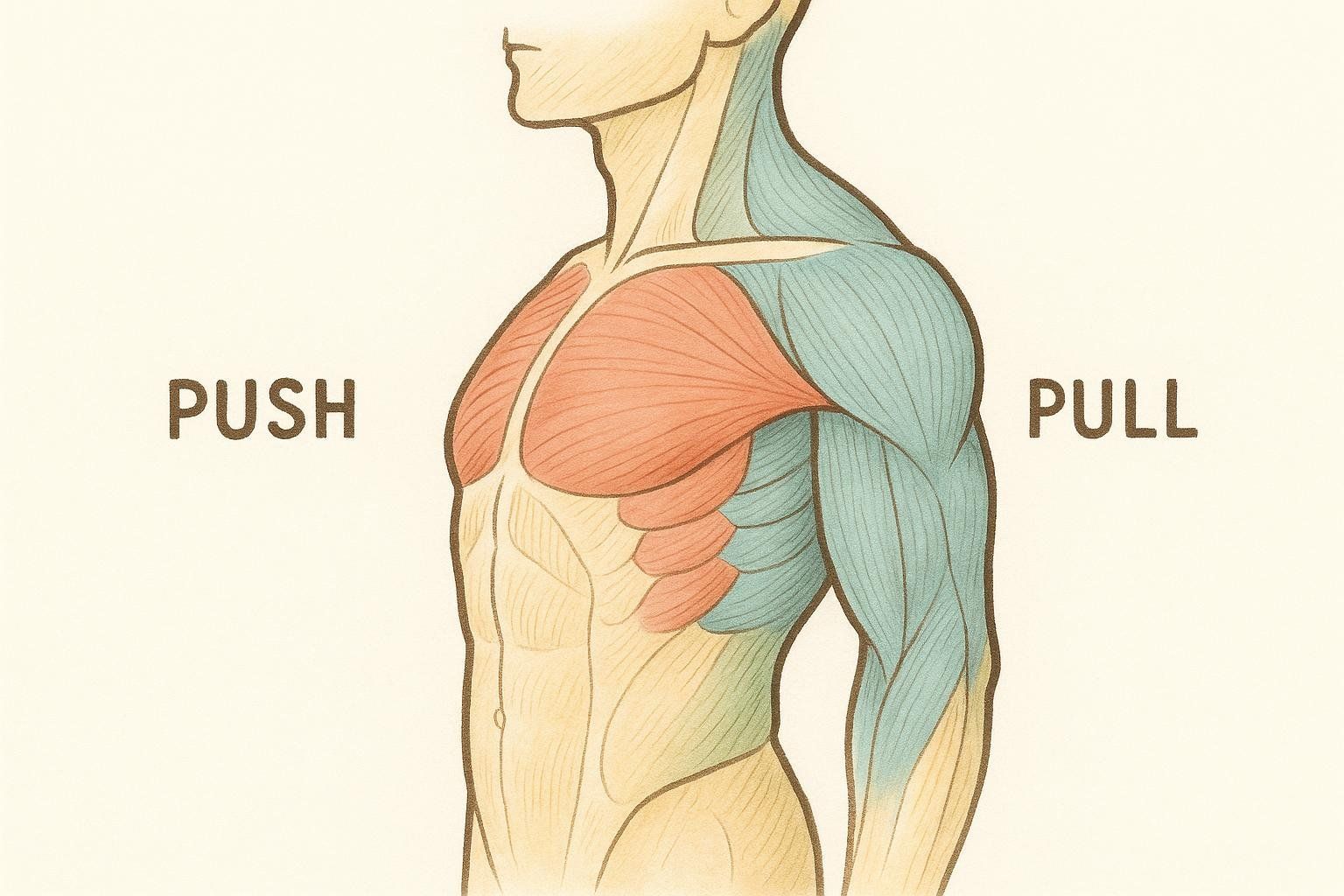How Many Push-Ups Should You Do Per Day?

How Many Push-Ups Should You Do Per Day? A Science-Based Guide
If you've ever wondered "how many push-ups should I do a day?", you're asking the right question—but the answer isn't just a single number. Your ideal daily push-up count depends on your current fitness level, goals, and what you hope to achieve. Whether you're building muscle, improving endurance, or just maintaining overall health, this guide provides science-backed recommendations for every level.
Push-ups are one of the most effective bodyweight exercises available. They work multiple muscle groups—chest, shoulders, triceps, and core—making them an excellent choice for building upper body strength and endurance. Research shows that push-up capacity is even linked to cardiovascular health, with men who could perform over 40 consecutive push-ups having a 96% lower risk of heart-related events compared to those who could do fewer than 10.
But here's the thing: the "perfect" daily number varies dramatically based on where you're starting and where you want to go.
Understanding Your Push-Up Goals

Before diving into specific numbers, let's clarify what different daily push-up routines can achieve:
For General Fitness and Health:
- Goal: Maintain basic upper body strength and cardiovascular benefits
- Focus: Consistency over intensity
For Muscle Building (Hypertrophy):
- Goal: Increase muscle size in chest, shoulders, and triceps
- Focus: Challenging volume with proper recovery
For Muscular Endurance:
- Goal: Perform more consecutive reps or maintain strength over longer periods
- Focus: Higher volume with moderate intensity
For Strength Development:
- Goal: Build maximum pushing power
- Focus: Progressive overload with challenging variations
To ensure proper growth and recovery, exercise science shows that effective programs should base training volume on individual capacity, not on arbitrary numbers.
Science-Based Daily Recommendations by Fitness Level
Complete Beginners (Can do 0-10 strict push-ups)
Recommendation Per Session: 10-20 push-ups
If you're new to push-ups, start conservatively. Research from the American Council on Exercise suggests beginners should focus on form and consistency rather than high volume.
Sample daily routine:
- 2-3 sets of 5-8 push-ups
- Rest 90 seconds between sets
- Perform every other day (3-4 days per week)
Progression strategy: Add 1-2 reps per week until you can perform 15 consecutive push-ups with good form.
Modifications for success:

- Start with incline push-ups (hands on a bench or step)
- Use knee push-ups if toe push-ups are too challenging
- Focus on controlled movement—2 seconds down, pause, 2 seconds up
Intermediate Level (Can do 11-25 strict push-ups)
Recommendation Per Session: 30-60 push-ups
At this level, you can handle more volume and begin working toward specific goals. Training programs typically recommend 2-3 sessions per week with moderate volume for intermediate trainees.
For muscle growth:
- 3-4 sets of 8-15 reps
- 60-90 seconds rest between sets
- Aim for 50-75 total reps if your max is under 25
For endurance:
- 3-5 sets of 10-15 reps
- 45-60 seconds rest
- Gradually increase total volume by 5-10 reps per week
Sample daily distribution:
- Morning: 15-20 push-ups (2 sets)
- Evening: 15-20 push-ups (2 sets)
- Or complete all sets in one session
Advanced Level (Can do 26+ strict push-ups)
Daily Recommendation: 75-150+ push-ups
Advanced trainees often perform 75-150 total push-ups daily, spread across multiple sets with varied intensity to challenge different aspects of strength and endurance.
Sample advanced routine:

- 5-6 sets of varying rep ranges (15-25 reps per set)
- Include different variations (diamond, decline, explosive)
- 60-90 seconds rest between sets
Progressive overload strategies:
- Add weighted vests or resistance bands
- Incorporate tempo work (slow negatives)
- Try advanced variations like archer push-ups or one-arm progressions
The Daily vs. Every-Other-Day Debate
One of the most common questions is whether you should do push-ups every day or take rest days. Exercise science principles provide clear guidance:
Daily push-ups are appropriate when:
- Volume is modest (10-20% of your maximum capacity)
- You're focusing on movement practice and consistency
- Your primary goal is general fitness maintenance
Every-other-day training is better when:
- You're training at higher intensities
- Your goal is muscle growth or strength gains
- You're experiencing any soreness or fatigue
Studies show that muscle protein synthesis peaks at 24 hours post-exercise and returns to baseline within 36-48 hours.
For muscle building, allowing 48-72 hours between intense sessions targeting the same muscle groups maximizes protein synthesis and adaptation.
How to Determine Your Personal Daily Target
Here's a practical framework based on exercise science research:
Step 1: Test Your Maximum
Perform a push-up test to determine your current one-set maximum:
- Warm up with arm circles and light movement
- Perform as many strict push-ups as possible
- Record your number
Step 2: Calculate Your Daily Range
Based on your maximum, use this framework adapted from strength coaching principles:
- Conservative approach (for consistency): 30-50% of your max
- Moderate approach (for steady progress): 60-80% of your max
- Aggressive approach (for rapid gains): 100-150% of your max
Example: If your max is 20 push-ups:
- Conservative: 6-10 daily push-ups
- Moderate: 12-16 daily push-ups
- Aggressive: 20-30 daily push-ups
Step 3: Adjust Based on Response
Monitor how your body responds after the first week:
- No soreness, easy to complete: Increase by 10-20%
- Mild soreness, challenging but doable: Maintain current level
- Significant soreness or declining performance: Reduce volume by 20-30%
How Many Push-Ups Should I Do a Day to See Results?
The minimum effective dose for seeing results depends on your current fitness level and what "results" means to you:
For strength improvements: You can see meaningful gains with as few as 15-25 push-ups per session, performed 3 times per week. Participants doing bodyweight exercises twice weekly for 8 weeks increased upper body strength significantly.
For muscle building: Research suggests you need 10-20 sets per week per muscle group for optimal hypertrophy. This translates to roughly 40-80 push-ups per session, 3-4 times per week, assuming each set contains 8-15 reps.
For endurance gains: You'll see improvements in muscular endurance with higher volume—50-100+ reps per session, depending on your starting capacity.
Timeline for visible results:
- Strength improvements: 2-3 weeks
- Muscle growth: 4-6 weeks
- Endurance gains: 1-2 weeks
What Happens if I Do 100 Push-Ups a Day?
Doing 100 push-ups daily can produce significant results, but the outcome depends heavily on how you distribute this volume and your starting fitness level:
Potential benefits:
- Increased muscular endurance: Your ability to perform consecutive push-ups will improve dramatically
- Upper body muscle development: Particularly in the chest, shoulders, and triceps
- Improved cardiovascular fitness: High-volume push-ups elevate heart rate and provide conditioning benefits
Potential drawbacks:
- Overuse Injuries and Strain: High daily volume without rest can strain the shoulders and wrists
- Plateaued Muscle Growth: Without progressive overload (increased difficulty), muscle growth stagnates after initial adaptation
- Imbalanced Development: Focusing solely on push-ups can create muscle imbalances
Smart approach to 100 daily push-ups:

- Spread the volume across multiple manageable sets (e.g., 5 sets of 20, 10 sets of 10) depending on your capacity
- Take 1-2 complete rest days per week
- Progress to harder variations (decline, weighted, single-arm progressions) after 4-6 weeks
- Include pulling exercises to maintain muscle balance
Will 50 Push-Ups a Day Build Muscle?
Yes, 50 push-ups per day can build muscle, especially for beginners, but effectiveness depends on several factors:
Who will see muscle growth:
- Beginners with limited upper body training experience
- Individuals who can currently perform fewer than 20 consecutive push-ups
- Those who haven't done regular resistance training
Optimal distribution for muscle building:
- 3-4 sets of 12-17 reps (rather than one set of 50)
- Performed every other day to allow recovery
- Focus on slow, controlled movement to maximize muscle tension
Timeline and expectations:
- Weeks 1-4: Noticeable strength and endurance improvements
- Weeks 4-8: Visible muscle development in chest and triceps
- Beyond 8 weeks: Plateau likely without progression to harder variations
To maximize muscle building with 50 daily push-ups:
- Progress to decline or weighted push-ups after 6-8 weeks
- Add protein intake to support muscle synthesis
- Include complementary exercises for balanced development
A 2017 study in the Journal of Sports Sciences showed that bodyweight training can produce similar muscle growth to weight training when volume and intensity are matched appropriately.
Is 20 Push-Ups a Day Good?
Twenty push-ups per day is an excellent starting point for many people and can provide meaningful health and fitness benefits:
Who benefits most from 20 daily push-ups:
- Complete beginners to exercise
- Individuals returning to fitness after time off
- Those focused on general health rather than specific performance goals
- People establishing a consistent exercise habit
Benefits of 20 daily push-ups:
- Habit formation: Builds the discipline of daily movement
- Strength maintenance: Helps preserve upper body strength
- Cardiovascular health: Provides light cardiovascular stimulus
- Functional fitness: Maintains pushing strength for daily activities
Expected outcomes:
- Improved ability to perform daily tasks requiring upper body strength
- Better posture and core stability
- Foundation for progressing to higher volumes or advanced exercises
- Mental satisfaction from consistent achievement
When to progress beyond 20 daily push-ups:
- When you can easily complete all 20 with perfect form
- After 3-4 weeks of consistent performance
- When your goals shift toward muscle building or advanced conditioning
Progression strategies:
- Increase to 25-30 reps while maintaining daily frequency
- Add a second set later in the day
- Progress to more challenging variations
- Combine with other bodyweight exercises for full-body routine
Research shows that even modest amounts of resistance exercise provide significant health benefits, with the American Heart Association recommending muscle-strengthening activities at least twice per week for optimal health.
Progressive Programs for Different Goals
30-Day Beginner Program
Weeks 1-2
Perform 3 sets of 5-8 reps (or modifications). Train 3 days per week with at least one rest day between sessions. Focus on form over speed.
Weeks 3-4
Progress to 3 sets of 8-12 reps. Maintain 3-day frequency. Aim to significantly improve your max reps, working towards 15 consecutive push-ups.
Muscle-Building Program (8 weeks)
Frequency: 3-4 days per week
Target Volume: 40-80 total push-ups per session, divided into sets of 8-15 reps
Program progression:
- Weeks 1-2: 40-50 total reps per session (4-5 sets of 8-12)
- Weeks 3-4: 50-65 total reps per session (4-6 sets of 10-15)
- Weeks 5-6: 65-80 total reps per session (5-6 sets of 12-15)
- Weeks 7-8: Reduce to 35-50 reps per session for recovery (deload week)
Advanced Endurance Challenge
Prerequisite: Ability to perform 30-35 consecutive push-ups
Target: Build toward 100 consecutive push-ups over 8-10 weeks
- Week 1-2: 4 sets, aiming to complete 15-20 reps per set with good form, 3 days per week
- Week 3-4: 3 sets, aiming for 20-30 reps per set, plus 1 final set to failure, 3 days per week
- Week 5-6: 3 sets, targeting 30-40 reps per set with good form, followed by one final set to failure, 3 days per week
- Week 7-8: Continue with 3-4 high-volume sets to near-failure, plus one weekly max test to track progress toward the 100-rep goal
- Week 9-10: Technique refinement and final max test attempt
Common Mistakes to Avoid
Mistake #1: Too Much, Too Soon
Many beginners attempt 50-100 push-ups on day one, leading to excessive soreness and often injury. Research shows that gradual progression prevents overuse injuries while still producing gains.
Mistake #2: Ignoring Form for Numbers

Quality trumps quantity every time. A 2017 study found that slower push-ups with a 3-second descent produced superior muscle activation compared to rapid repetitions. Focus on:
- Full range of motion (chest nearly touching ground)
- Straight body line from head to heels
- Controlled movement both up and down
Mistake #3: Neglecting Other Muscle Groups

Push-ups primarily work "pushing" muscles. Balance your routine with pulling exercises like:
- Pull-ups or chin-ups
- Band pull-aparts
- Inverted rows
- Face pulls
Mistake #4: No Progression Plan
Simply doing the same number daily won't produce long-term gains. Your body adapts quickly, so you need progressive overload through:
- Increased volume
- Challenging variations
- Added resistance
Signs You're Doing Too Many (or Too Few)
Signs that you might be doing too many push-ups include:
- Persistent soreness lasting >48 hours
- Declining performance over several days
- Sharp pain in wrists, elbows, or shoulders
- Inability to maintain proper form
Indicators that your routine may include too few push-ups are:
- No muscle fatigue during or after sets
- No improvement in strength or endurance after 2-3 weeks
- Routine feels "too easy"
- No visible or measurable progress
Tracking Your Progress

Method 1: Weekly Max Tests
Every 7-10 days, retest your maximum consecutive push-ups to track strength gains.
Method 2: Volume Tracking
Log your daily and weekly push-up totals to monitor training load and recovery.
Method 3: Body Composition Changes
For those focused on muscle building, tracking lean mass changes is a reliable way to see progress. DEXA scans can measure arm muscle development with precision, showing exactly how push-up training affects upper body composition.
When to Adjust Your Daily Target
Increase your daily number when:
- You can easily complete all sets with perfect form
- You've maintained current volume for 2+ weeks without challenge
- Your weekly max test improves by 10+ reps
- You have specific goals requiring higher volume
Decrease your daily number when:
- You experience persistent fatigue or soreness
- Form deteriorates consistently
- You miss multiple training days due to overuse
- Other life stresses are high (work, travel, illness)
Adjustments for Different Populations and Goals
For older adults: Adults over 50 should prioritize consistency over intensity. Start conservative and focus on maintaining muscle mass and functional strength rather than pursuing aggressive volume goals.
During weight loss: Push-ups can help preserve muscle during caloric deficits. If you're losing weight, maintain your push-up routine but be aware that performance may plateau or even temporarily decrease due to reduced energy availability. Ensure you maintain adequate protein intake to support muscle preservation during this period.
For athletes: Sport-specific demands may require modified approaches. Contact sport athletes might benefit from explosive variations, while endurance athletes may prefer higher-volume, lower-intensity protocols.
Optimizing Your Push-Up Results
Pre-Training Preparation
- Dynamic warm-up (arm circles, cat-cows, light movement)
- Activation exercises (band pull-aparts, scapular push-ups)
- Proper hydration status
Post-Training Recovery
- Static stretching for chest, shoulders, and triceps
- Light movement to promote blood flow
- Adequate protein intake within 2 hours
Sleep and Nutrition
Quality sleep (7-9 hours) is crucial for muscle recovery and strength gains. Protein intake of 1.6-2.2g per kg body weight optimizes muscle protein synthesis for those engaged in resistance training.
Beyond the Numbers: Building a Sustainable Routine
Consistency is the single most important factor for long-term success—the best program is always the one you can follow consistently.
Tips for long-term success:
- Start small: Better to do 5 push-ups daily for a month than 50 for three days
- Track progress: Use apps, journals, or simple calendars to monitor consistency
- Celebrate milestones: Acknowledge improvements in strength, endurance, or form
- Adjust expectations: Progress isn't always linear; expect plateaus and adapt accordingly
- Make it convenient: Identify times and places where push-ups fit naturally into your routine
Taking It to the Next Level
If you're just starting out and can only perform a few push-ups at a time, our 8-Week Push-Up Challenge for Beginners provides a systematic program designed to help you reach 100 consecutive push-ups—a true milestone of upper body endurance.
For those interested in broader strength development, explore our guides on building bigger biceps and building muscle mass to complement your push-up routine with comprehensive upper body training.
Conclusion: Your Personal Push-Up Prescription
The question "how many push-ups should I do a day?" doesn't have a universal answer—it has a personal one. Your ideal daily number depends on your current abilities, specific goals, recovery capacity, and lifestyle factors.
For most people, the sweet spot is:
- Beginners: 10-20 reps per session, performed every other day
- Intermediate: 30-60 reps per session, 3-4 days per week
- Advanced: 75-150+ reps per session, programmed thoughtfully
Remember that consistency beats perfection. It's better to do a moderate number of push-ups regularly than to attempt ambitious numbers sporadically. Start with a conservative target, focus on perfect form, and gradually progress based on your body's response.
Whether your goal is general fitness, muscle building, or athletic performance, push-ups can be a valuable tool in your fitness arsenal. Use the science-based recommendations in this guide as a starting point, then adjust based on your individual response and goals.
Most importantly, the best routine is adaptable and based on your own data. Listen to your body, track your progress using the methods outlined, and build a personalized plan to achieve your strength goals safely and effectively.


